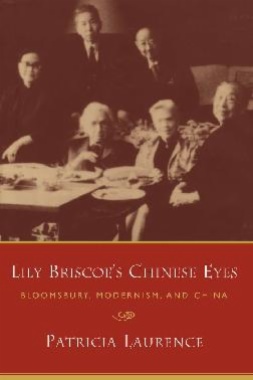A map of the mutual influence of Bloomsbury, the Crescent Moon Society, and modernism in English and Chinese culture
Lily Briscoe's Chinese Eyes traces the romance of Julian Bell, nephew of Virginia Woolf, and Ling Shuhua, a writer and painter Bell met while teaching at Wuhan University in China in 1935. Relying on a wide selection of previously unpublished writings, Patricia Laurence places Ling, often referred to as the Chinese Katherine Mansfield, squarely in the Bloomsbury constellation. In doing so, she counters East-West polarities and suggests forms of understanding to inaugurate a new kind of cultural criticism and literary description.
Laurence expands her examination of Bell and Ling's relationship into a study of parallel literary communities—Bloomsbury in England and the Crescent Moon group in China. Underscoring their reciprocal influences in the early part of the twentieth century, Laurence presents conversations among well-known British and Chinese writers, artists, and historians, including Virginia Woolf, Vanessa Bell, G. L. Dickinson, Xu Zhimo, E. M. Forster, and Xiao Qian. In addition, Laurence's study includes rarely seen photographs of Julian Bell, Ling, and their associates as well as a reproduction of Ling's scroll commemorating moments in the exchange between Bloomsbury and the Crescent Moon group.
While many critics agree that modernism is a movement that crosses national boundaries, literary studies rarely reflect such a view. In this volume Laurence links unpublished letters and documents, cultural artifacts, art, literature, and people in ways that provide illumination from a comparative cultural and aesthetic perspective. In so doing she addresses the geographical and critical imbalances—and thus the architecture of modernist, postcolonial, Bloomsbury, and Asian studies—by placing China in an aesthetic matrix of a developing international modernism.
- Cover
- Contents
- List of Illustrations
- Foreword
- Acknowledgments
- Abbreviations
- Historical Time Line
- Introduction
- Images on a Scroll
- Maps of Seeing
- The Historical Moment
- The Formation of Literary Communities and Conversations in China and England
- The Uses of Letters
- Empiricizing the Theoretical
- Evolving Modernisms
- CHAPTER ONE: Julian Bell Performing “Englishness”
- The Sentimental and the Modern: Pei Ju-Lian (Bell, Julian) Teaching in China
- The Provincial Turns Political
- From Fairy Stories to Letter Quarrels: Julian Bell and Ling Shuhua
- Translating Together: Julian Bell and Ling Shuhua
- CHAPTER TWO: Literary Communities in England and China: Politics and Art
- Imagining Other Communities: The Crescent Moon Group
- Politics and Art
- A Parallel Community: Bloomsbury
- CHAPTER THREE: East-West Literary Conversations: Exploring Civilization and Subjectivity—G. L. Dickinson and Xu Zhimo
- Terms That Fold and Unfold Meaning: Civilization and Subjectivity
- Xu Zhimo: “The Great Link with Bloomsbury”
- An English Don in a Chinese Cap: G. L. Dickinson
- The Cultivation of the Romantic Self: Xu Zhimo
- Feeling as a Transgressive Act: The Narration of “Self” in Developing Chinese Modernism
- Redefinitions of British “Civilization”: G. L. Dickinson
- The Unwritten Passage to China: E. M. Forster and Xiao Qian
- “The Unpopular Normal”: E. M. Forster’s Expanding Notions of Transnational Sexuality, Culture, and the British Novel
- Swallowing and Being Swallowed: Poverty in China and the British Novel
- British Modernism through Chinese Eyes: Katherine Mansfield, D. H. Lawrence, James Joyce, T. S. Eliot, and Virginia Woolf
- Interrupted Modernism
- CHAPTER FOUR: Chinese Landscapes through British Eyes
- The Naturalist Landscape: Julian Bell
- The Painter’s Eye: Vanessa Bell and Ling Shuhua
- Constructing the “Narrow Bridge of Art”: Virginia Woolf and Ling Shuhua
- China on a Willow Pattern Plate: Charles Lamb, George Meredith, and Arthur Waley
- Expanding “Englishness”: Le Jardin Anglo-Chinois and the Kew Gardens Pagoda
- CHAPTER FIVE: Developing Modernisms
- Incorporating “Chinese” Eyes
- Chinoiserie and the International Chinese Exhibition
- “The Liquidation of Reference”
- The Aesthetic Gaze
- The Epistemology of Boundaries: Subject and Object
- The Crisis in Representation: Aesthetic Reciprocity
- Leaving Things Out: The Line
- Flatness and Plasticity
- The Literary Effect of Visual Aesthetics
- Postscript
- APPENDIX A: Index of Chinese and British Figures
- APPENDIX B: Selection from Ling Shuhua’s Story “Writing a Letter” with Julian Bell’s Annotations
- APPENDIX C: Table of Contents, Selections of Modernist Literature from Abroad, eds. Yuan Kejia, Dong Xengxun, Zheng Kelu, 1981
- Notes
- Bibliography
- Index
- A
- B
- C
- D
- E
- F
- G
- H
- I
- J
- K
- L
- M
- N
- O
- P
- Q
- R
- S
- T
- U
- V
- W
- X
- Y
- Z

